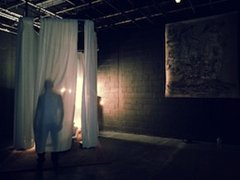U-R-HAMLET TOO is actor Conor Madden’s second attempt to pick apart the nature of art, spectatorship, and theatrical meaning using the indecisive Danish Prince as a point of departure. An earlier version of the show, U-R-HAMLET, was developed and performed last year as part of the 'Show in a Bag' initiative, produced by Fishamble and the Dublin Fringe Festival. In U-R-HAMLET-TOO, Madden and director Jason Byrne seem bent on boiling the Prince down to his essence by stripping away even more of the context that helped situate the original 'Show in a Bag' production.
The motives of Shakespeare’s Hamlet, a grieving son bidden to avenge his father’s murder by the dead man’s ghost, have generated a complex nexus of interpretations down the ages. Is the madness Hamlet exhibits a cunning ploy to draw out his murderous uncle, or has Hamlet genuinely gone bonkers? An actor who’s playing Hamlet is forced, generally speaking, to perform a character whose very existence is predicated on the question of whether or not what he’s doing is real or ‘merely’ a performance. With that in mind, boiling Hamlet down to his indivisible elements appears to be an impossible task, as his actions are always up for myriad interpretations by performers, directors and audiences alike. Tackling this task, in full awareness of the impossibility of success, seems to be part of the point of U-R-HAMLET-TOO.
After a welcome and original take on the fire announcement (sung with mournful earnestness by actor/musician Derrick Devine), Madden, accompanied at intervals by Devine and his guitar, launches into halting streams of consciousness musing on mindfulness and reality, expanding definitions of art, who or what an audience is, and iambic pentameter. Madden’s wanderings find their way to some of Shakespeare’s text, fleetingly referring to Man as “the beauty of the world, the paragon of animals” or quoting at length Hamlet’s advice to the Players. Clarence’s speech from Richard III, describing a vivid dream of drowning, finds its way into the mix as well.
 Byrne places his performers in a ghostly and evocative space lit only by side table lamps and a work light. The back wall of the space is dominated by John Fitzsimons' eerie black and white painting, reminiscent of a Gothic/Renaissance woodcut, casting our minds back to the chaotic fecundity of Hamlet’s historical and cultural origins. The bathtub-bound Devine is kept distanced from the audience behind a thin membrane of white curtains, and only the dim shadows of his silhouette mark him out as truly corporeal. The overall effect is that of a ghostly rite tinged with a little knowing irony seeping through Devine and Madden’s brief disembodied exchanges and Devine’s somewhat sardonic songs.
Byrne places his performers in a ghostly and evocative space lit only by side table lamps and a work light. The back wall of the space is dominated by John Fitzsimons' eerie black and white painting, reminiscent of a Gothic/Renaissance woodcut, casting our minds back to the chaotic fecundity of Hamlet’s historical and cultural origins. The bathtub-bound Devine is kept distanced from the audience behind a thin membrane of white curtains, and only the dim shadows of his silhouette mark him out as truly corporeal. The overall effect is that of a ghostly rite tinged with a little knowing irony seeping through Devine and Madden’s brief disembodied exchanges and Devine’s somewhat sardonic songs.
By all accounts, the previous incarnation of this show, U-R-HAMLET, had a more specific contextual frame shedding brighter light on the themes Madden is wrestling with. There Madden was apparently playing himself, a version of himself and an actor preparing to play Hamlet as the countdown to an offstage performance of the tragedy drove the action towards an inevitable end. There’s no such context here, so determining the meanings of Madden’s messages is left to the discerning gaze of the audience. This can be a little frustrating at first, as one is left to sit wondering what the audience’s relationship to Madden should be. When Madden, standing a few feet from the first row, greets the audience with a “hello” in the middle of the performance, he’s simply met with bemused silence. Are we meant to speak? Are we a part of this performance or merely observers? As with the rest of the nearly hour-long performance, Madden and director Byrne’s intention is never made entirely clear, but then the purpose may be to highlight the problematic relationship between the watchers and the watched, and the determination of meaning within that relationship. Perhaps a little bit more of a contextual nudge, in the form of a more open engagement with the audience, would have better defined and clarified the production’s argument here.
What Madden’s musings do suggest is that if the reality of Hamlet rests anywhere, it more than likely rests in the imagination of the audience, whose varied experiences and contexts can generate a host of Hamlets through the act of looking and listening. Madden and Byrne are perhaps inviting the audience to draw their own conclusions from the raw material presented, or to at least to experience the befuddlement experienced by both Hamlet and those who attempt to concretely interpret his actions.
Of course, without the clarity of a context, the production’s motives (like those of Hamlet’s) are a little difficult to adequately pin down. Still, while intention may at times be either befuddled or willfully obfuscated, Madden, Byrne, and Devine do succeed in forcing their audience to actively re-examine their relationship to the performer, and the audience’s important role in determining meaning within the theatrical frame.
Jesse Weaver completed his doctoral thesis at University College Cork in 2011. His research focus was on the changing roles of the playwright in Irish theatre production from 1980 to 2010.